
TURRET
PROJECT COMPLETED FOR MEAM 348 LAB - SPRING 2020
Solidworks
OVERVIEW
This project was for MEAM 348, the Mechanical Engineering Junior Design Lab and I worked on it with a group of eight other students, divided into subteams where I mainly worked with Maddie Magee and Roselyn Matlou on the base of the turret. The goal of the project was to fabricate a complex machine that will have catastrophic failures at 2.5 times the nominal load and our team chose to manufacture a turret from the video game Portal. In Portal, a turret will open its wings to show that it is activated and therefore, our turret's main purpose was to open and close its wings, with failure modes for the chassis, wings and base.
My subteam focused on the base of the turret which supported the body by three legs and was designed to undergo torsional failure when the mass of the body was added. Given the unprecedented situation with COVID-19, we were not able to fabricate and test our turret, however we used Solidworks and ANSYS to test various failure modes and validate integration of all the parts.

FAILURE ANALYSIS
In order to make our failure "catastrophic" and "interesting", as stated in our lab prompt, we attempted to make the legs fail in torsion rather than bending. This is a unique challenge as it is not possible currently to mathematically derive this torsional failure and instead, we relied on modeling softwares (Solidworks and ANSYS) which could be validated through fabrication and testing.
The Finite Element Analysis (FEA) of our designs were modeled with acrylic and the nominal load for the legs was calculated from the mass of the chassis, wings, and motor to be 3.095kg or a resultant force of 53.7N. The unstable model successfully reached yielding stress at 45MPa at that force and the stable model only reached 15.6 MPa at the same x2.5 nominal load.


DESIGN DECISIONS
In designing the base for the turret, we wanted to maintain the original turret's three-legged support structure, but after doing an initial test with just the three legs, decided to add an a lower plate that would attach to the legs for additional support.
Once we received an estimate of mass from the other two subteams, we were able to perform analyses with the updated load on our design and saw that it would not be able to sustain the applied load. Since the load was focused on the inner circle of the upper base, the design would cave in on itself and the legs would not be able to support the localized load as the supports were at a larger radius from the center. Since the highest concentration of stresses were found at the angled areas of the legs, we decided to change the design toward a more tabletop design with the legs angled toward the center then extending straight toward the ground.
After obtaining a final mass for the chassis and wings, we updated and ran our analyses on the two designs: the first with legs angled out from the body and the second with legs angled inward then extending outward. While we had previously thought that the first design would not be able to support the load because of the shape of the legs, when we increased the thickness of the legs and analyzed both designs, they resulted in similar stress concentrations. Finally, we decided on the first design with thicker legs since it was more true to the Portal turret design.

